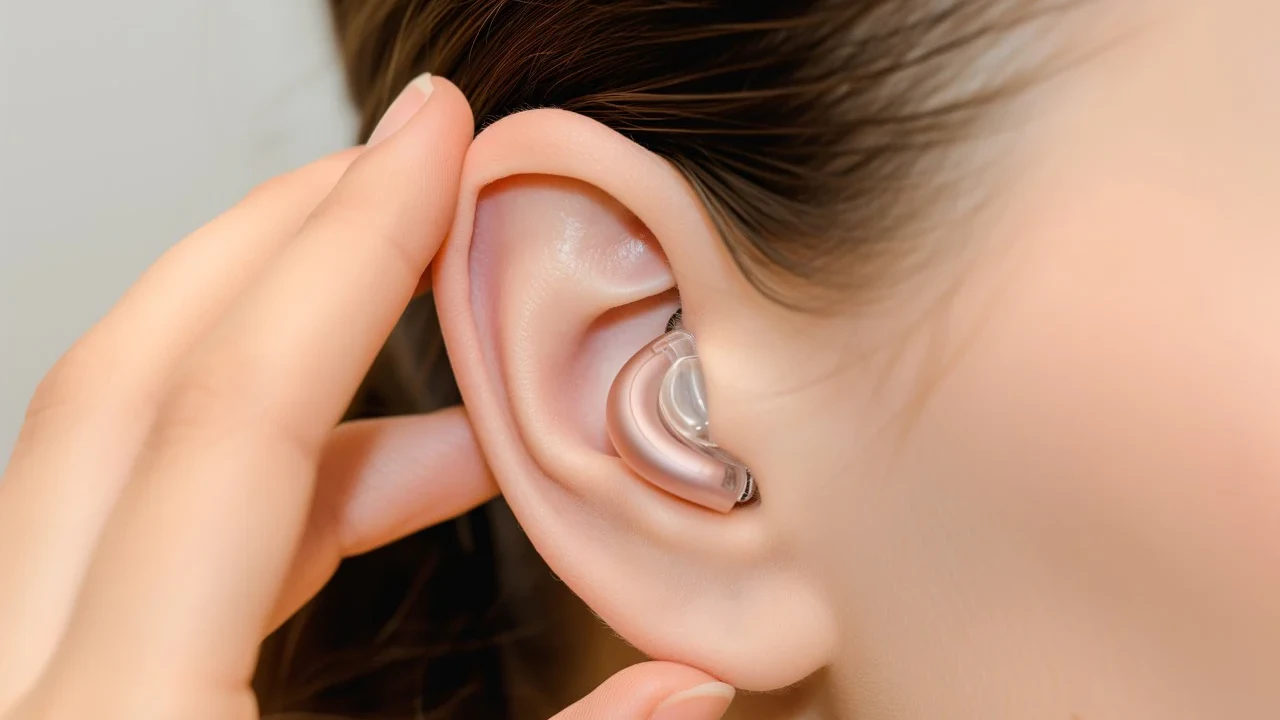Common Hearing Aid Problems and Solutions
Troubleshoot common hearing aid issues like feedback, low volume, or discomfort. Find practical solutions to keep your devices working optimally.

Troubleshoot common hearing aid issues like feedback, low volume, or discomfort. Find practical solutions to keep your devices working optimally.
Common Hearing Aid Problems and Solutions
Hey there! So, you've got your hearing aids, and they're generally doing a great job, right? But let's be real, sometimes they can act a little finicky. Just like any piece of tech, hearing aids can run into a few snags. The good news is, most common problems are super easy to fix yourself, saving you a trip to the audiologist. We're talking about those annoying whistles, sounds cutting out, or maybe just a bit of discomfort. Don't sweat it! This guide is here to walk you through the most frequent issues and give you some straightforward solutions to get your hearing aids back to tip-top shape. We'll even dive into some specific product recommendations and scenarios to help you out.
Understanding Hearing Aid Feedback and Whistling Sounds
Ah, the dreaded whistle! Hearing aid feedback is probably one of the most common and irritating issues. It's that high-pitched squeal that can pop up out of nowhere. But what exactly causes it?
Think of it like this: your hearing aid is an amplifier. It picks up sound, makes it louder, and sends it into your ear. Feedback happens when that amplified sound escapes your ear and gets picked up by the hearing aid's microphone again, creating a loop. It's a bit like holding a microphone too close to a speaker – instant screech!
Common Causes of Hearing Aid Feedback
- Improper Fit or Loose Earmold: This is a big one. If your earmold or the hearing aid itself isn't sitting snugly in your ear, sound can leak out and get picked up by the microphone. This is especially common with BTE (Behind-The-Ear) and RIC (Receiver-In-Canal) styles if the dome or mold isn't the right size or is inserted incorrectly.
- Excess Earwax Buildup: Earwax is natural, but too much of it can block your ear canal, pushing the hearing aid out slightly or reflecting sound back towards the microphone. It can also block the sound outlet, causing sound to build up and escape.
- Cracked or Damaged Tubing/Earmold: For BTE hearing aids, the clear tubing connecting the aid to the earmold can crack or become stiff over time, creating tiny gaps for sound to escape. Earmolds can also crack or shrink.
- Volume Too High: Sometimes, simply turning the volume up too high can cause feedback, especially if your hearing aid's feedback cancellation system is struggling to keep up.
- Proximity to Objects: Holding your hand too close to your ear, wearing a hat, or even leaning against a wall can sometimes cause temporary feedback as sound bounces back to the microphone.
- Malfunctioning Microphone or Speaker: Less common, but sometimes the internal components can be faulty, leading to persistent feedback.
Solutions for Hearing Aid Feedback
Let's get rid of that whistle!
- Check the Fit: First, gently reinsert your hearing aid. Make sure it's seated correctly and snugly in your ear canal. If you have a BTE with an earmold, ensure the earmold is fully inserted. If you use domes, try a slightly larger size if they feel loose. Many audiologists provide different dome sizes during your fitting.
- Clean Your Ears and Hearing Aids: Use a soft cloth to wipe down your hearing aids daily. For earwax, if you suspect a buildup, consult your doctor or audiologist. Never use cotton swabs inside your ear canal as this can push wax further in. Your audiologist can safely remove earwax.
- Inspect Tubing and Earmolds: For BTE users, check the tubing for cracks, stiffness, or discoloration. If it looks worn, it's time for a replacement. Your audiologist can usually do this quickly. Also, inspect your earmold for any visible damage.
- Adjust Volume: Try turning the volume down slightly. If the feedback stops, you might have just had it a bit too loud for the current environment.
- Keep Clear of Obstructions: Be mindful of how you're holding your phone, wearing glasses, or if anything is pressing against your ear.
- Professional Check-up: If none of these work, it's definitely time to see your audiologist. They can check for internal damage, adjust the programming (many modern hearing aids have advanced feedback cancellation systems that can be fine-tuned), or recommend a new earmold if yours has changed shape over time.
Addressing Low or Intermittent Sound from Hearing Aids
Nothing's more frustrating than your hearing aid suddenly going quiet or cutting in and out. It's like trying to listen to a radio station with bad reception. Let's figure out why this might be happening.
Reasons for Low or Intermittent Sound
- Dead or Low Battery: This is the most obvious culprit! Batteries don't last forever, and when they're running low, your hearing aid's performance will suffer.
- Blocked Microphone or Receiver: Earwax, dirt, or debris can easily clog the tiny microphone ports or the receiver (speaker) opening, preventing sound from getting in or out.
- Moisture Damage: Sweat, humidity, or even rain can get into the delicate electronics of your hearing aid, causing it to malfunction.
- Damaged Tubing or Wire: For BTEs, the tubing can become blocked with moisture or wax. For RICs, the thin wire connecting the main unit to the receiver in your ear can get damaged.
- Program Settings: You might accidentally be on a program setting that's designed for a very quiet environment, or perhaps a telecoil setting that's not picking up ambient sound.
- Connectivity Issues (Bluetooth Models): If you're streaming audio via Bluetooth, a weak connection or interference can cause intermittent sound.
- Internal Component Failure: Less common, but sometimes a component inside the hearing aid can fail, leading to sound issues.
Solutions for Low or Intermittent Sound
Let's get that sound flowing again!
- Change the Battery: Always start here! Replace your battery with a fresh one. If you have rechargeable hearing aids, ensure they are fully charged. If the problem persists with a new battery, the issue lies elsewhere.
- Clean Thoroughly: Use the brush and wax pick provided with your hearing aids to carefully clean around the microphone ports and the sound outlet (receiver/speaker). Pay close attention to wax guards – these tiny filters protect the receiver and need regular replacement. Most manufacturers recommend changing them every few weeks or when sound becomes muffled.
- Dry Your Hearing Aids: If you suspect moisture, place your hearing aids in a drying kit or dehumidifier overnight. These are inexpensive and can save your devices from moisture damage. Avoid using heat sources like hair dryers.
- Check Tubing/Wire: For BTEs, detach the tubing and check for blockages. You can use an air blower to clear it. For RICs, inspect the thin wire for any kinks or visible damage. If damaged, it needs professional replacement.
- Verify Program Settings: Cycle through your hearing aid programs to ensure you're on the correct one. If you have a smartphone app, check the settings there.
- Troubleshoot Bluetooth: If it's a streaming issue, try disconnecting and reconnecting your hearing aids to your phone. Ensure your phone's Bluetooth is on and there's no interference from other devices.
- Audiologist Visit: If these steps don't resolve the issue, your audiologist can perform diagnostics, replace wax guards, or send the hearing aid for repair if there's internal damage.
Dealing with Discomfort and Soreness from Hearing Aids
Your hearing aids should be comfortable! If they're causing pain, itching, or soreness, something isn't quite right. It's like wearing shoes that are too tight – you just can't ignore it.
Causes of Hearing Aid Discomfort
- Improper Fit: This is the most common reason. An earmold or dome that's too large, too small, or not shaped correctly for your ear can cause pressure points, rubbing, or a feeling of fullness.
- Allergic Reaction: Though rare, some people can be sensitive to the materials used in earmolds or domes.
- Ear Canal Irritation: New users might experience some initial irritation as their ears adjust. Also, excessive cleaning or scratching can irritate the delicate skin.
- Earwax or Debris: Sometimes, a piece of earwax or a foreign object can get trapped between the hearing aid and your ear canal, causing discomfort.
- Changes in Ear Shape: Our ears can change shape over time, especially with weight fluctuations, which can affect the fit of custom earmolds.
Solutions for Hearing Aid Discomfort
Let's make those hearing aids feel good!
- Reinsert and Adjust: Gently remove and reinsert your hearing aid, ensuring it's seated properly without forcing it. Sometimes a slight adjustment in angle can make a big difference.
- Give It Time (New Users): If you're new to hearing aids, give your ears a few days to adjust. Wear them for shorter periods initially and gradually increase wear time.
- Keep Ears Clean: Ensure your ears are clean and free of excessive earwax. If you have an itchy ear, avoid scratching with sharp objects.
- Lubricants (Temporary): Your audiologist might recommend a special lubricant for temporary use if the earmold is causing friction. Do not use petroleum jelly or other household lubricants.
- Audiologist Consultation: This is crucial for discomfort. Your audiologist can:
- Reshape or Remake Earmolds: If the fit is off, they can grind down pressure points or take a new impression for a custom earmold.
- Change Dome Size/Type: For RICs, trying different dome sizes or styles (e.g., open vs. closed) can significantly improve comfort.
- Check for Allergies: They can assess if an allergic reaction is likely and recommend alternative materials.
- Inspect Ear Canal: They can check for any underlying ear conditions or irritations.
Troubleshooting Connectivity Issues with Bluetooth Hearing Aids
Modern hearing aids often come with fantastic Bluetooth capabilities, letting you stream calls, music, and TV directly to your ears. But sometimes, getting them to connect or stay connected can be a bit of a headache.
Common Bluetooth Connectivity Problems
- Pairing Failure: Your hearing aids just won't connect to your phone or other device.
- Intermittent Connection: Sound cuts in and out, or the connection drops frequently.
- Poor Sound Quality: Audio sounds distorted, choppy, or has a delay.
- Difficulty Switching Devices: You want to switch from your phone to your tablet, but it's not cooperating.
Solutions for Bluetooth Connectivity
Let's get you seamlessly connected!
- Restart Everything: The classic tech fix! Turn off your hearing aids, turn off your phone/device, wait 30 seconds, then turn them all back on.
- Re-Pair Devices: Go into your phone's Bluetooth settings, 'forget' or 'unpair' your hearing aids, then go through the pairing process again as if they were new devices.
- Check Proximity: Ensure your hearing aids and the connected device are within the recommended Bluetooth range (usually about 30 feet or 10 meters) and there are no major obstructions.
- Minimize Interference: Other Bluetooth devices, Wi-Fi routers, and even microwaves can sometimes interfere with the signal. Try moving away from these sources.
- Update Software: Make sure your hearing aid app and your phone's operating system are both up to date. Manufacturers often release updates to improve connectivity.
- Check Hearing Aid Battery: Low battery on your hearing aids can affect Bluetooth performance.
- Consult Your Audiologist/Manufacturer Support: If persistent, your audiologist can check for firmware updates on your hearing aids or help troubleshoot specific app settings. The hearing aid manufacturer's support line is also a great resource for Bluetooth issues.
Specific Product Recommendations and Scenarios
While many problems have universal solutions, some hearing aids excel in certain areas or offer unique features that can help mitigate common issues. Let's look at a few examples.
For Persistent Feedback Issues
If you're constantly battling feedback, you need hearing aids with robust feedback cancellation systems. These systems actively detect and cancel out the whistling sound before you even hear it.
- Phonak Lumity Series (e.g., Phonak Audeo Lumity L90-R): Phonak is renowned for its AutoSense OS technology, which includes excellent feedback management. The Lumity series offers advanced algorithms that are very effective at suppressing feedback, even in challenging situations. They are RIC (Receiver-In-Canal) style, rechargeable, and offer great connectivity.
- Oticon More Series (e.g., Oticon More 1 miniRITE R): Oticon's MoreSound Intelligence and MoreSound Amplifier technologies work together to provide a clear soundscape while actively managing feedback. Their open sound approach aims to reduce the need for aggressive feedback suppression by processing sound more naturally. These are also RIC, rechargeable, and offer strong connectivity.
Scenario: You're a new hearing aid user with a mild-to-moderate hearing loss, and you find yourself getting a lot of feedback when you move your head or wear glasses. A well-fitted RIC like the Phonak Lumity or Oticon More, with their advanced feedback cancellation, would be a great starting point. Your audiologist would ensure the dome or custom mold provides a secure, leak-free fit, and fine-tune the feedback manager.
Estimated Price Range: For these premium models, expect to pay between $3,000 - $7,000 per pair, depending on the technology level and included services from your provider.
For Blockages and Maintenance Concerns
If you have a lot of earwax or live in a humid climate, you need hearing aids that are easy to clean and durable against moisture and debris.
- Starkey Genesis AI (e.g., Starkey Genesis AI RIC RT): Starkey's Genesis AI line boasts an IP68 rating, meaning they are highly resistant to dust and water. They also feature a robust wax guard system that is relatively easy for users to change. Their design often incorporates smooth surfaces, making them easier to wipe clean.
- ReSound OMNIA (e.g., ReSound OMNIA 9 RIC): ReSound also offers excellent durability with an IP68 rating. Their wax guards are designed for easy replacement, and the overall construction is built to withstand daily wear and tear, including exposure to sweat and humidity.
Scenario: You're an active individual who sweats a lot, or you naturally produce a good amount of earwax. You need hearing aids that can stand up to these challenges and are easy to maintain. The Starkey Genesis AI or ReSound OMNIA would be excellent choices due to their high IP ratings and user-friendly maintenance features. Regular cleaning and daily use of a drying kit would be essential.
Estimated Price Range: Similar to the above, premium models from these brands typically range from $2,800 - $6,500 per pair.
For Connectivity and Streaming Reliability
If seamless connection to your smartphone, TV, or other devices is a top priority, you'll want hearing aids known for their robust Bluetooth capabilities.
- Widex Moment Sheer (e.g., Widex Moment Sheer 440 sRIC R D): Widex is known for its pure, natural sound, and their Moment Sheer line offers excellent direct streaming capabilities for both iOS and Android devices. Their Bluetooth connection is generally very stable, and the companion app is intuitive for managing settings and connections.
- Signia Pure Charge&Go AX (e.g., Signia Pure Charge&Go AX 7AX): Signia's Augmented Xperience (AX) platform provides dual processors, allowing for separate processing of speech and background noise, which also benefits streaming quality. They offer reliable Bluetooth connectivity and often come with a StreamLine TV accessory for high-quality TV audio.
Scenario: You rely heavily on your smartphone for calls and streaming music, and you want a hearing aid that connects effortlessly and provides clear audio. You also watch a lot of TV and want to stream directly. The Widex Moment Sheer or Signia Pure Charge&Go AX would be strong contenders, offering stable Bluetooth and dedicated accessories for TV streaming.
Estimated Price Range: These high-end models typically fall within the $2,500 - $6,000 per pair range.
General Tips for Optimal Hearing Aid Performance
Beyond troubleshooting specific issues, there are some general best practices that can keep your hearing aids running smoothly and prevent many problems from occurring in the first place.
Daily Care and Maintenance for Hearing Aids
- Clean Daily: Make it a habit to wipe down your hearing aids with a soft, dry cloth every evening before bed. Use the provided brush and wax pick to clear any debris from the microphone and receiver ports.
- Change Wax Guards Regularly: These tiny filters are your hearing aid's first line of defense against earwax. Replace them as recommended by your audiologist or when you notice sound becoming muffled.
- Store Properly: When not in use, store your hearing aids in their charging case (for rechargeable) or in a drying kit/dehumidifier. This protects them from moisture and keeps them safe from pets or accidental damage.
- Handle with Care: Always hold your hearing aids over a soft surface (like a towel) when changing batteries or cleaning, just in case you drop them.
Battery Management for Hearing Aids
- Keep Spares: Always carry spare batteries if you use disposable ones. Check the expiration date on battery packs.
- Recharge Regularly: For rechargeable models, get into the habit of charging them every night.
- Proper Disposal: Dispose of old batteries responsibly according to local regulations.
Regular Audiologist Check-ups
- Annual Appointments: Even if your hearing aids seem fine, annual check-ups with your audiologist are crucial. They can perform professional cleaning, check for internal issues, update programming, and ensure your hearing aids are still meeting your needs.
- Don't Delay for Issues: If you've tried the basic troubleshooting steps and the problem persists, don't wait! Contact your audiologist. Early intervention can often prevent minor issues from becoming major repairs.
Remember, your hearing aids are an investment in your quality of life. Taking good care of them and knowing how to handle common issues will ensure you get the best possible hearing experience every single day. If you're ever in doubt, your audiologist is always your best resource!
:max_bytes(150000):strip_icc()/277019-baked-pork-chops-with-cream-of-mushroom-soup-DDMFS-beauty-4x3-BG-7505-5762b731cf30447d9cbbbbbf387beafa.jpg)






